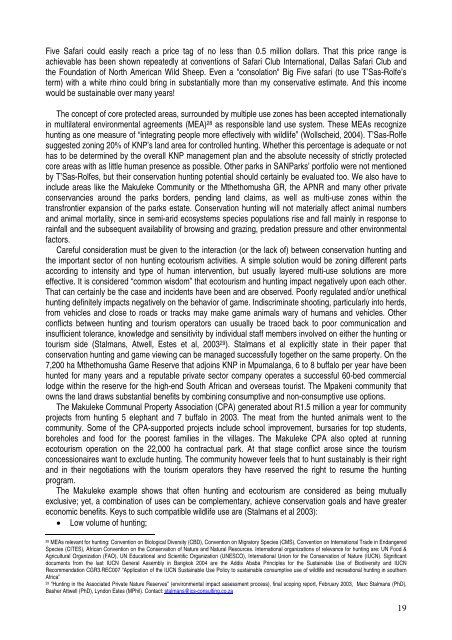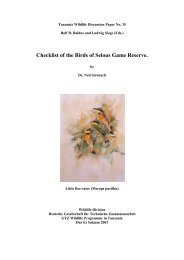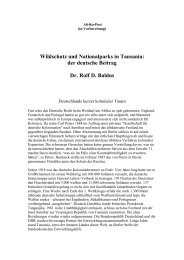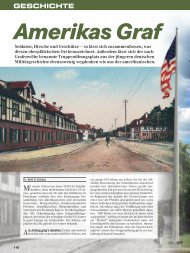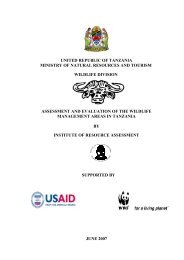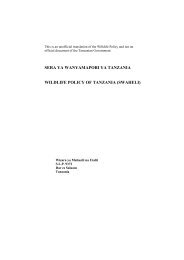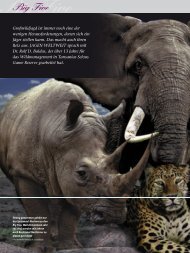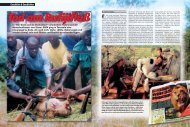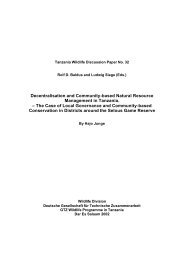African Indaba Articles - wildlife-baldus.com
African Indaba Articles - wildlife-baldus.com
African Indaba Articles - wildlife-baldus.com
Create successful ePaper yourself
Turn your PDF publications into a flip-book with our unique Google optimized e-Paper software.
Five Safari could easily reach a price tag of no less than 0.5 million dollars. That this price range isachievable has been shown repeatedly at conventions of Safari Club International, Dallas Safari Club andthe Foundation of North American Wild Sheep. Even a "consolation" Big Five safari (to use T’Sas-Rolfe’sterm) with a white rhino could bring in substantially more than my conservative estimate. And this in<strong>com</strong>ewould be sustainable over many years!The concept of core protected areas, surrounded by multiple use zones has been accepted internationallyin multilateral environmental agreements (MEA) 28 as responsible land use system. These MEAs recognizehunting as one measure of “integrating people more effectively with <strong>wildlife</strong>” (Wollscheid, 2004). T’Sas-Rolfesuggested zoning 20% of KNP’s land area for controlled hunting. Whether this percentage is adequate or nothas to be determined by the overall KNP management plan and the absolute necessity of strictly protectedcore areas with as little human presence as possible. Other parks in SANParks’ portfolio were not mentionedby T’Sas-Rolfes, but their conservation hunting potential should certainly be evaluated too. We also have toinclude areas like the Makuleke Community or the Mthethomusha GR, the APNR and many other privateconservancies around the parks borders, pending land claims, as well as multi-use zones within thetransfrontier expansion of the parks estate. Conservation hunting will not materially affect animal numbersand animal mortality, since in semi-arid ecosystems species populations rise and fall mainly in response torainfall and the subsequent availability of browsing and grazing, predation pressure and other environmentalfactors.Careful consideration must be given to the interaction (or the lack of) between conservation hunting andthe important sector of non hunting ecotourism activities. A simple solution would be zoning different partsaccording to intensity and type of human intervention, but usually layered multi-use solutions are moreeffective. It is considered “<strong>com</strong>mon wisdom” that ecotourism and hunting impact negatively upon each other.That can certainly be the case and incidents have been and are observed. Poorly regulated and/or unethicalhunting definitely impacts negatively on the behavior of game. Indiscriminate shooting, particularly into herds,from vehicles and close to roads or tracks may make game animals wary of humans and vehicles. Otherconflicts between hunting and tourism operators can usually be traced back to poor <strong>com</strong>munication andinsufficient tolerance, knowledge and sensitivity by individual staff members involved on either the hunting ortourism side (Stalmans, Atwell, Estes et al, 2003 29 ). Stalmans et al explicitly state in their paper thatconservation hunting and game viewing can be managed successfully together on the same property. On the7,200 ha Mthethomusha Game Reserve that adjoins KNP in Mpumalanga, 6 to 8 buffalo per year have beenhunted for many years and a reputable private sector <strong>com</strong>pany operates a successful 60-bed <strong>com</strong>merciallodge within the reserve for the high-end South <strong>African</strong> and overseas tourist. The Mpakeni <strong>com</strong>munity thatowns the land draws substantial benefits by <strong>com</strong>bining consumptive and non-consumptive use options.The Makuleke Communal Property Association (CPA) generated about R1.5 million a year for <strong>com</strong>munityprojects from hunting 5 elephant and 7 buffalo in 2003. The meat from the hunted animals went to the<strong>com</strong>munity. Some of the CPA-supported projects include school improvement, bursaries for top students,boreholes and food for the poorest families in the villages. The Makuleke CPA also opted at runningecotourism operation on the 22,000 ha contractual park. At that stage conflict arose since the tourismconcessionaires want to exclude hunting. The <strong>com</strong>munity however feels that to hunt sustainably is their rightand in their negotiations with the tourism operators they have reserved the right to resume the huntingprogram.The Makuleke example shows that often hunting and ecotourism are considered as being mutuallyexclusive; yet, a <strong>com</strong>bination of uses can be <strong>com</strong>plementary, achieve conservation goals and have greatereconomic benefits. Keys to such <strong>com</strong>patible <strong>wildlife</strong> use are (Stalmans et al 2003):• Low volume of hunting;28 MEAs relevant for hunting: Convention on Biological Diversity (CBD), Convention on Migratory Species (CMS), Convention on International Trade in EndangeredSpecies (CITES), <strong>African</strong> Convention on the Conservation of Nature and Natural Resources. International organizations of relevance for hunting are: UN Food &Agricultural Organization (FAO), UN Educational and Scientific Organization (UNESCO), International Union for the Conservation of Nature (IUCN). Significantdocuments from the last IUCN General Assembly in Bangkok 2004 are the Addis Ababa Principles for the Sustainable Use of Biodiversity and IUCNRe<strong>com</strong>mendation CGR3.REC007 “Application of the IUCN Sustainable Use Policy to sustainable consumptive use of <strong>wildlife</strong> and recreational hunting in southernAfrica”29 “Hunting in the Associated Private Nature Reserves” (environmental impact assessment process), final scoping report, February 2003, Marc Stalmans (PhD),Basher Attwell (PhD), Lyndon Estes (MPhil). Contact: stalmans@ics-consulting.co.za19


